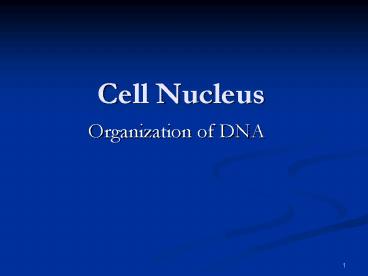Cell Nucleus - PowerPoint PPT Presentation
1 / 26
Title:
Cell Nucleus
Description:
Facultative heterochromatin contains genes that are shut off and temporarily inactive. ... Facultative vs. Constitutive Heterochromatin. Constitutive Heterochromatin ... – PowerPoint PPT presentation
Number of Views:119
Avg rating:3.0/5.0
Title: Cell Nucleus
1
Cell Nucleus
- Organization of DNA
2
Agenda
- Euchromatin and heterochromatin
- Organization of DNA as chromatin
- the histones
- a role for chromatin organization in gene
expression - Please read third ed. Fourth ed.
- DNA packaging 501-507 498-507
- Nuclear matrix 515-516 514-516 (fig 12.26)
- Gene structure 521-539 520-537
3
Interphase chromatin
- DNA is an exercise in packing and organization
- the animal genome is written in 3 X 109
nucleotide bases. - DNA contains the 30,000 different genes
- in humans this is divided into 46 chromosomes,
each an unbroken strand. - A total of 2m in the nucleus of 10mm in diameter
- Although it cant be seen in interphase, each
unwound chromosome does have an organized
location in the nucleus. (see fig. 12.23 (third
ed.) 12.21 second ed.) - Held in place on the nuclear matrix and nuclear
lamina. Protein frameworks
4
Interphase chromatin
Chromatin structure is only visible as denser and
lighter regions
5
- Euchromatin
- The regions of DNA containing active genes.
- Dispersed, active DNA
- Lighter appearance, located in interior of
nucleus - Autoradiography with 3H uridine demonstrates that
this region is active in producing RNA - Uridine is a raw material for new RNA, not DNA.
6
Heterochromatin
- Inactive, condensed chromatin
- located at the edges of the nucleus
- visible by E.M. as a darker colour.
- Two reasons why they are condensed
- a) inactive genes, such as chromosome 18
- This will vary with cell type, depending if genes
are active - b) regions without genes. Non-coding DNA.
7
- Centromeres
- the constricted central portion of a each
chromosome, - the DNA contains a-satellite DNA made up
non-transcribed 171 base repetitive sequences. - Repeated many thousands of times
- Attach to the kinetochores during M phase
- Telomeres
- non-coding regions at the ends of the
chromosomes. - Short repeated sequence repeated 500-5000X
- TTAGGGTTAGGGTTAGGG
- Serve to separate chromosomes from each other
- Anchor to the nuclear lamina.
8
(No Transcript)
9
Heterochromatin
- Two types
- Constitutive heterochromatin is non-coding and so
can never become active - Facultative heterochromatin contains genes that
are shut off and temporarily inactive. -depends - In any cell only a portion of all the genes are
active - Example the Barr Body. Females have two X
chromosomes, one of which is inactive (fig. 12.15)
10
Facultative vs. Constitutive Heterochromatin
Facultative Heterochromatin
telomere
Both chromosome 18
Euchromatin in interior of nucleus
Facultative Heterochromatin Barr Body inactive
X. Euchromatin Active X-chromosome
Interphase nucleus
Constitutive Heterochromatin around centromere
and telomere
Telomere
Cytoplasm
11
DNA Packaging
- Structural and Functional Aspects
12
Level 1 Histones
- DNA winds around nucleiosomes, which are a group
of positively charged, highly conserved proteins
13
Histone Varieties
- Nucleosome core particle made up of four types of
histones, two of each - Histones H2A, H2B, H3 and H4
- DNA wraps around the nucleosomes. 1.8 turns or
146 nucleotide bases per nucleosome - Histone H1 (fifth type)
- links adjacent nucleosome core particles.
- A total of 167 nucleotide bases per unit
- 71 packing ratio, the fiber is 10 nm thick
14
H2A
H2B
H3
H4
naked DNA
nucleosome core particle
nucleosomes
Add H1
H1
- 168 bp in loop - 6 to 7 fold shortening - 10
nm fiber
H1
H1
H1
H1
15
Level 2 30 nm Fibres
- Spontaneous assembly of adjacent nucleosomes
results in a 401 condensation in length, with 30
nm thick fibres
16
H1
17
Level 3 Looped Domains
18
Looped Domains
- DNA strands associate with nuclear matrix
- Form loops of 20,000 to 100,000 bases
- AT-rich domains on DNA form MARS
- Matrix Associated Region
- Includes a satellite and other non-coding DNA
- proteins of the scaffold include 4 types of
binding material
19
Looped DNA domains
Nuclear matrix fig 12.26 (both eds.)
20
Scaffold Proteins
- Nuclear matrix
- a protein fiber framework
- major organizing structure for RNA polymerase
(makes messenger RNA), RNA processing, DNA
replication. - Topoisomerase II
- an un-tangling protein
- Insulator Protein
- keeps loops separate
- Nuclear lamina
- lamins bind telomeres and a satellite DNA of the
centromere
21
Level 4Mitotic Chromosomes
22
Mitotic Chromosomes(a 10,000 fold decrease in
length)
- Also have looped domain structure
- No Nucleus is present
- DNA loops on Condensin protein
- SARs scaffold associated regions
- More compact than interphase chromatin
- Condensin is activated by phosphorylation via Cdk
(cyclin dependent kinase) - Centromere is a site of condensation
- contains a-satellite DNA
- binds to proteins, including the kinetochore
23
The Histone Code
- DNA is being transcribed and duplicated
- Necessary machinery has to work around
nucleosomes - The cell makes DNA more or less accessible to
other proteins by modifying histones - Mechanisms of Histone modification
- Replacement with modified types of histone
- Chemical modification of the histones
24
(No Transcript)
25
Modified Types of Histones
- H2AX
- DNA being repaired
- H2AZ and H3.3
- DNA transcribed by RNA polymerase II
- CNEP-A (a version of H3)
- on the centromere, kinetochore assembly
- macroH2A
- barr body
- keeps chromatin condensed and inactive.
26
Chemical Modification of Histones
- Acetylated histones looser binding
- Phosphorylated histones
- Methylated histones
- Alter the accessibility of DNA to processing
enzymes - Alter binding to organizational structures such
as nuclear matrix































